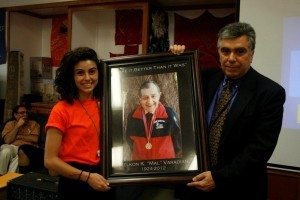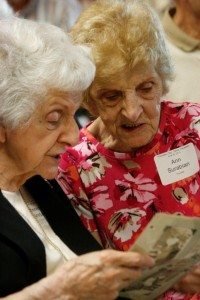FRANKLIN, Mass.— They came with picks and shovels, ready to churn the earth. They arrived in the back of pickup trucks and overloaded sedans, primed to build their oasis in the middle of a desert.

Tebi Haiastan. On to Camp Haiastan.
The era was the late 1940’s and every available hand was prepared to work its fingers to the bone, with calluses and abrasions part of their reward. Nobody complained. A mission was ready to unfold that would allow thousands of young Armenian-Americans an opportunity to enhance their culture and discover their roots. The youth must be served.
Last month, right here in Franklin, just south of Boston, overlooking Uncas Pond at the crossroads of Ararat, Founders Day on June 26 reunited close to 40 of these early settlers together.

They had helped develop this property at a time when resources were scant and the country was still reeling from the after-effects of the Great War. Many had served their time on the battleground and returned home to face yet another challenge—that of reuniting with their AYF peers and getting the camp built.
The reunion coincided with Teenage Week, when 70 youth were on hand to greet and meet these founders and hear their stories. One day they, too, will carry the torch.
The fact it marked the sixth decade of activity only heightened the moment. The founders here from all points of New England and beyond, enjoyed the camaraderie, toured the grounds, took notice of the vast changes, exchanged memories, and dined together.
The teens served as hosts and hostesses, leading the prayer and other formalities. Many founders had the pleasure of seeing their children and grandchildren in attendance. An eclectic PowerPoint presentation on camp history by former director and committee member Mesrob Odian proved the coup de grace.
Among the other highlights was a presentation by Michael Varadian of a photograph of his late father Malcolm, a camp icon prior to his death last year. Well into his 80s, Mal Varadian made frequent trips to the camp with guys like Odian and Kushigian, educating the campers and keeping them mobilized.
“It was a chance to educate the campers, thank the camp builders, record some camp history, and have the founders reminisce with their AYF peers,” said Chairman Harry Kushigian. “So many of us have enjoyed the fruits of their labors. What you’re seeing here is Camp Haiastan’s greatest generation.”

Kushigian has a long and venerable history here. He was a counselor during the second to fourth seasons, from 1951-53, a counselor for three seasons, and director in 1962 at age 22, before he joined the camp board in the 1970’s. Now he’s part of the group that brought the founders together.
The committee uncovered some 110 founders still living; of that number, 35 expressed an interest in attending. Among those not able to attend was Paul Piligian, who lives these days in California. He remembers the day when the army surplus cabins were delivered and arranged in a circle.
“There are not many of us left,” wrote Piligian, who lived on a chicken farm in Franklin. “What a wonderful project to record for posterity. I hope the young attendees get an appreciation of all the work put in by the founders.”
Though 96, Knar Babayan’s memory of her early camp experiences remains transfixed. She sent the food to the working class. Her late husband Vigen was among a group of “invisible heroes” who supplied the camp with steady materials and donations, especially with Gatorade.
“Service above self” was Vigen’s mantra. “There have been so many unsung heroes of the camp who never asked for recognition or even a plaque with their name on it,” said daughter Sona (Babayan) Petrossian. “They just asked what the camp needed and went out and did it. All of my dad’s years in industry helped the camp, from butter, oil, and yes, Gatorade.”
Arko Arakelian, now 90, made several cassettes for Johnny Berberian from his huge Artie Barsamian and Vosbikian original 78 RPM records. The music he provided formed a wonderful backdrop. Another legally blind guest didn’t let his impediment keep him home, and took his place in the front row.
“I can’t tell you how happy that made him,” said Barbara Berberian, his niece and a committee member. “He’s been ill and can hardly talk, but he remembers carrying wood planks to make a floor in one of the buildings.”
For others like Theresa Brundage who needed a ride from Peabody, Mgo Kassabian was at her doorstep ready to transport. The photo album held in her hands was a litany of camp history. She felt right at home with many of her Providence cohorts.
Going back an eon, Brundage’s mother was Kushigian’s Armenian schoolteacher at this camp. When the teens were being recognized, among those standing was Kushigian’s granddaughter.
Credit the Karentz family with three generations. There was Rose, the grandmother; Daneb, the aunt; and Sarah, a camper for the ninth time all the way from Fort Lauderdale, Fla.
At a time when nobody thought a female could handle the director’s job, Lucy Almasian proved them wrong. Her granddaughter was there to greet here. Lucy was among the committee members.
“I noticed a lot of tears in the audience, myself included,” she said. “They are not to be forgotten for their unselfish efforts in getting this camp entrenched for future generations.”
Many like Odian started as a camper and went through the chain of command. He has a vested interest in this camp for what it did for him as a consummate Armenian. He’d like to pass a little of that veneer to the youngsters.
“Who would have ever thought that what we built 63 years earlier would continue to flourish like this?” said Odian. “This camp is a product of immigrants, AYFers, and alumni. General Nejdeh galvanized the youth here. It’s the only place where the tricolor is flown every day, with ‘Mer Hairenik’ sung and the ‘Hayr Mer’ recited. People like Bob Avakian nurtured the seed and helped cultivate this legacy.”
Founders like Dusty Cotter of Worcester recalled how she used to “scrounge around” for a ride when it came to a work session.
“We froze our butts off in the back of an open truck,” she laughed. “We cleared away poison ivy. Sometimes, we paid the consequences. It was all sweat labor without the tools you have today. I look back on those memorable days and say I did my part to build this camp.”
Three sons and a grandchild reaped the benefits, giving her reassurance.
“It was a time for work but also a time for fellowship and purpose,” indicated Arpie Koroghlian. “As part of the Cambridge AYF, we returned to clear up that piece of land many times.”
If you’re looking for the first registered camp counselor, look no further than Haig Der Manuelian. He was there sporting his usual dose of trivia.
“The years of taking academics in school never trained me to be a carpenter,” he revealed. “But we learned fast.”
Doc Bedrosian reminded all of how fortunate he was to be born an Armenian. Astor Guzelian is another product of three generations. He was 15 when the camp reached out to him.
“I never realized the impact this would have on my family,” he confirmed. “It’s where the past meets the present and the future.”
The day also served as an introduction for new executive director Dave Hamparian, who took over the helm from Roy Callan.
“Over 60 years ago, these founders unselfishly gave their time, their blood, sweat, and tears,” he said. “I stand before you paying homage for all you’ve done here. For our campers, they are being exposed to a live history lesson. Walk away and remember that our elders are not old but wise. Their eyesight is not failing for they have vision.”
Hamparian was a camper for seven years and became a director in 1990. He was active with the AYF and Boston Homenetmen, along with St. Stephen’s Church.
Representing the board was Mike Bahtiarian, who passed out one verbal accolade after another. He pointed to ongoing projects like a new sanitation system now taking place.
“Even now in our 63rd year, the work continues,” said Bahtiarian. “Record-setting sessions are growing typical every summer.”
Also returning from last year was Hagop Soulakian of Chicago, who appears to be quite comfortable in his new role as summer director.
The date was May 1951. The New York “Hyortik” AYF Junior Chapter had awarded a one-week scholarship to Camp Haiastan for $25. The recipient happened to be Armen Boyajian. He considers himself the very first camper in AYF history.
The rest has turned into a personal lifestyle that is still very poignant and consistent today, despite the passage of time.


Be the first to comment